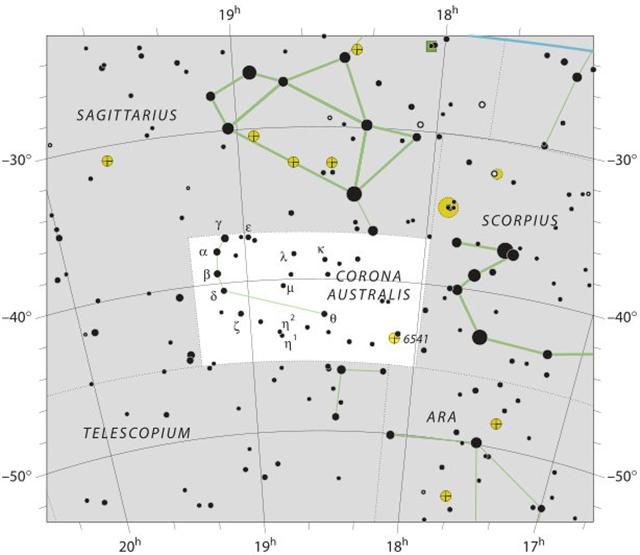Another important day was clearly Al Baldah 1, perhaps because it was 314 days after March 21:
Gb1-21 is a unique type of glyph and the following rau hei possibly represents Balder (which in Arabic perhaps became Al Baldaah). In rongorongo times the star Al Baldah (π Sagittarii, at the neck of the Archer) rose in day 290 (cfr Ca11-6 and at precisely the same time as Alphekka Meridiana (α in the upside down Southern Crown). This 'tine' is seemingly searching for the heart of the Archer Horse:
The measure π taken twice is needed to count the full circle around and therefore it is easy to create a connection between 314 and half the cycle of the year. At day 314 the front half of the year, 'Balder', would be succeeded by the other half of the year, his halfbrother 'Höder'. A little dot in front in Gb1-23 maybe was intended to show where manzil day 260 (= 20 * 13) was ending, where also January was ending. 365 + 31 = 396 and 396 - 260 = 136. The star Al Baldah (290.1) rose with Sun in day 80 + 290 = 370 = 365 + 5 = manzil day (370 - 136) = 234 = 258 (Al Baldah 1) - 24. Cfr Ca14-30 below. The distance from Sirius (181) to Murzim 1 (216) was 35 days (= 5 weeks). Apparently the beginning of the manzils are later than the dates when their ruling stars rose with the Sun, but these distances are not the same (not constant) and instead they could have symbolic values. 5 (rima) e.g. would suit the greateast of the fiery stars and 24 the last moment of the front half of the year. In Gb1-21, the image has the front 'twin' higher up than the left, which seems to indicate more light in front than at the back side. The one who 'died' at the end of January was not Balder but Höder. I guess Váli (possibly Sun ruling for himself all the year around) slew Höder at the end of January. In C the date Al Baldah 1 (January 29) is indicated by a complex moko figure with a wilting hand in front and a slender ihe tau (hokohuki) at left. The following inoino has 3 + 1 rhombs in a vertical arrangement, with the last one (at the top) smaller than the earlier 3:
Al Naam 12 (256) = January 27 (392) should have been an important day too. There are no mata on the pair of inoino signs in the days 392-393. The number of glyphs on side a of the C tablet is 392 and 393 = 193 (July 12 and the heliacal rising of Castor) + 200. 16 * 16 = 256. In Gb1-19 (249 days after March 21) there appears to be an arrow shot straight down, possibly towards Höder (the southern half of the sky and the abode of Sun until perhaps the end of January). In Ca12-8, at the end of this great old story, in manzil day 268, the 'head' part of mauga suggests Sun could once again be in the north. | ||||||||||||||||||||||||||||||||||||||||||||||||||||||||||||||||||||||||||||||||||||||||||||||||||||||||||||||||||||||||||||||||||||||||||||||||||||||||||||||||||||||||||||||||||||||||||||||||||||||













